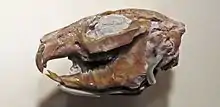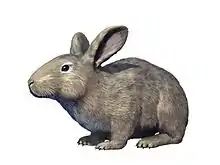Palaeolagus
Palaeolagus ('ancient hare') is an extinct genus of lagomorph.[2] Palaeolagus lived in the Oligocene period which was about 33-23 million years ago. The earliest leporids described from the fossil record of North America and Asia date to the upper Eocene some 40 million years ago.
| Palaeolagus | |
|---|---|
 | |
| Palaeolagus haydeni | |
| Scientific classification | |
| Kingdom: | |
| Phylum: | |
| Class: | |
| Order: | |
| Family: | |
| Subfamily: | †Palaeolaginae |
| Genus: | †Palaeolagus Leidy, 1856 |
| Species | |
| |
Taxonomy
The fossil remains of rabbits are scanty and those specimens that have been found are often too fragmentary to determine satisfactory the relationship with living forms. The bones of rabbits and hares are lightweight and fragile in structure, and so they are not easily preserved as fossils. Most of the species are inhabitants of uplands where conditions are not ideal for preservation. In a few deposits, rabbit remains seem numerous but many fossil species are known only from a few teeth and bones.
Description
The 25 centimetres (9.8 in) long creature closely resembled modern rabbits. They were common herbivorous inhabitants of the savanna, plains and woodlands of North America 30 million years ago.
Gallery


References
- Palmer, D., ed. (1999). The Marshall Illustrated Encyclopedia of Dinosaurs and Prehistoric Animals. London: Marshall Editions. p. 285. ISBN 1-84028-152-9.
- Haaramo, Mikko (2008-03-11). "Mikko's Phylogeny archive". Retrieved 2009-02-01.